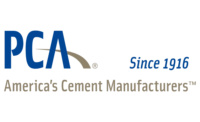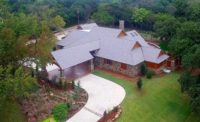Tackling the climate crisis on a global scale can seem like a daunting, if not impossible, challenge. However, retrofitting existing building stock represents one of the most effective and attainable ways to lower energy demand and carbon emissions, since buildings account for up to 30 percent of all energy consumption.
Deep energy renovations of buildings are critical if cities want to tackle their climate emissions on a large scale. Energy renovation could provide up to 55 percent of the reductions in greenhouse gas emissions needed to meet 2030 targets, aligning cities with a 1.5 degrees Celsius (34.7 degrees Fahrenheit) trajectory—the aim of the Paris Climate Agreement.
Typical renovation rates are 1 to 2 percent of the building stock per year, with an average energy use intensity reduction of less than 15 percent. However, to reach sustainable development and climate targets, EUI reductions should be between 30 to 50 percent¹.
Project Highlight: Ken Soble Tower Project, Hamilton, Ontario
The Ken Soble Tower Project sought to rehabilitate a post-war apartment building in this Canadian city. The 146-unit building was completely upgraded, inside and out, to achieve Passive House standard. The cladding design included a 6-inch thick stone wool EIF system. Architects chose this system due to the non-combustibility and the excellent moisture control offered by both the stone wool and the unique, built-in drainage layer cut into the back side of the insulation, as well as the liquid applied water resistive barrier used in the EIF system. In all, 50,000 square feet of stone wool insulation was incorporated into the new façade, helping to realize the R-38 effective R-value required to achieve EnerPHIT Passive house certification, while reducing greenhouse gas emissions by an impressive 94 percent.
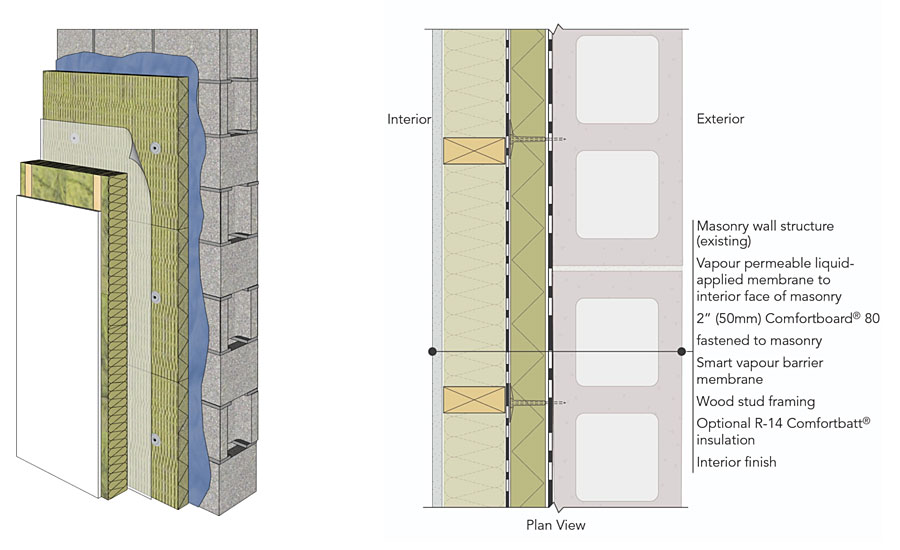 Comfortboard installed on the interior of an existing CMU construction, with optional batt insulation between a wood frame. Photo Credit: ROCKWOOL
Comfortboard installed on the interior of an existing CMU construction, with optional batt insulation between a wood frame. Photo Credit: ROCKWOOL
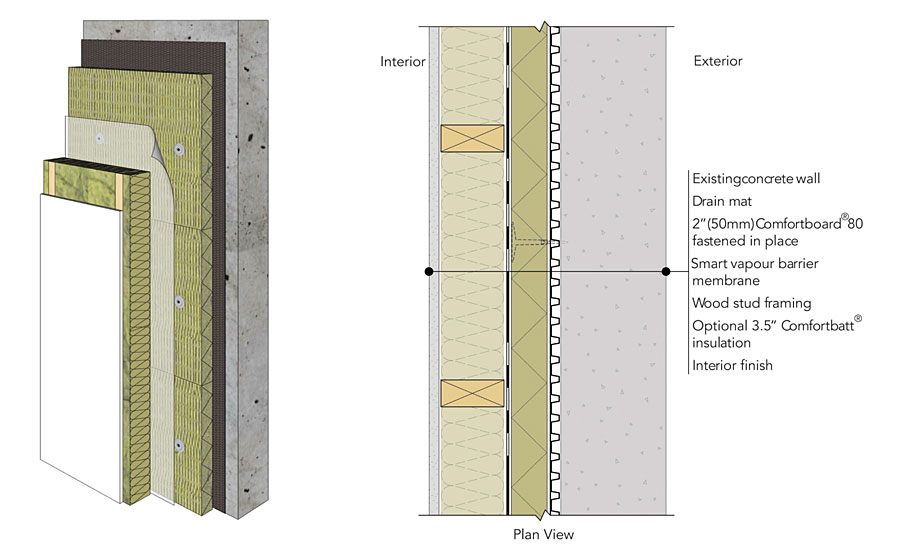 Comfortboard installed on the interior of an existing concrete tilt-up construction, with optional batt insulation installed between a wood frame. Photo Credit: ROCKWOOL
Comfortboard installed on the interior of an existing concrete tilt-up construction, with optional batt insulation installed between a wood frame. Photo Credit: ROCKWOOL
Retrofit planning
Optimize energy efficiency and improve indoor environment.
A building retrofit comes with unique conditions and challenges, requiring a holistic and long-term planning approach to ensure a project achieves its overall goals and targets.
A comprehensive plan should begin with the following:
- Auditing the building's existing conditions;
- Assessing potential energy conservation measures that will be applied (passive and active);
- Analyzing cost and long-term capital requirements;
- Understanding the social and economic effects on the building occupants (current and future).
ECMs include passive strategies, such as envelope improvements and active strategies, such as mechanical systems upgrades. Since the building envelope affects approximately 50 percent of the energy demand of typical buildings, implementing envelope-related ECMs is an effective way to reduce energy demand and operational carbon emissions of a building.
When deciding on enclosure-specific ECMs, consideration for thermal efficiency, durability, structural capacity and constructability, among others, is necessary. Therefore, understanding the unique challenges of different enclosure retrofit options is critical to ensure appropriate solutions are applied. Some of those options include both interior and exterior insulation retrofits, as well as addressing energy loss through various roof assemblies.
Stone wool insulation is an effective and versatile solution gaining traction among architects, designers, builders and contractors by contributing to energy efficiency, moisture management, fire protection and sound control, as well as building resilience and sustainability, among other project goals.
Exterior Insulation Retrofits
Thermal Efficiency
For exterior insulation systems, thermal reductions caused by the cladding attachment system are critical. A variety of options and materials exist. While each system is different, the approach often has continuous framing, intermittent clip and rail, direct fastening with screws or other engineered systems. The thermal efficiency of the various methods is dependent on the material and spacing requirements. There are often structural capacity constraints for retrofit projects.
Examples include how much the existing wall substrate can carry and if cladding attachments need to span from floor to floor. In these cases, the cladding attachment is typically more robust, and may cause significant thermal bridging. For optimal performance, windows should align with the exterior insulation. If upgrading windows is not part of the enclosure retrofit—or if it is impossible to move a window’s placement—wrapping the frame and ledge with insulation can improve performance.
Durability
Working on the exterior side of the enclosure allows for new water control strategies to be applied, such as appropriate cladding and overhang design to ensure proper water deflection, and the inclusion of a water-resistant barrier to act as a drainage plane. The addition of exterior insulation also serves as a supplementary drainage plane for the enclosure, inherently limiting the moisture amount that passes through the insulation. This approach increases the interior surface temperatures and reduces the potential for vapor diffusion and air leakage-related interstitial condensation at critical layers of the assembly. However, the type of exterior insulation will play a role in the overall performance of this system. When using vapor permeable exterior insulation such as stone wool, increased drying potential and outward drying is possible as the insulation will not trap moisture within the assembly.
Constructability
For exterior insulation, standard attachment strategies, such as continuous girts or clip and rail systems, are usually the easiest to install. More modern attachment strategies, such as thermally broken clip systems or direct fastening, while gaining traction, may require additional analysis and contractor training. Other site considerations are also necessary. For example, in densely populated areas, an exterior retrofit may bring more execution challenges than a building located in a less dense area, due to the proximity to other facilities, access to the site, and the potential for increased pedestrian disturbance and safety measures.
Project Highlight: Iconic heritage building, Habitat 67
Perched on the banks of Montreal’s riverfront, Habitat 67 is an historical landmark, a building commissioned as part of Canada’s Expo 67 centennial celebrations. The goal of the renovation was to increase its energy efficiency while respecting the building’s heritage designation. Stone wool insulation was installed on the interior as a continuous layer, providing improved comfort, energy efficiency, safety and durability. Residents will benefit from more stable and homogenous indoor temperatures, as well as passive fire protection due to the building’s non-combustible stone wool insulation, all while maintaining the historic landmark aesthetic.
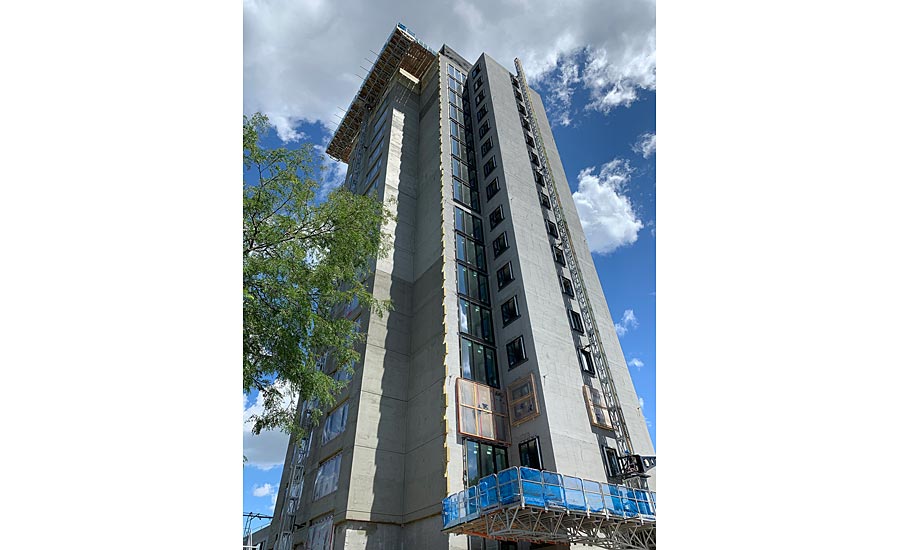 Photo courtesy of ERA Architects
Photo courtesy of ERA Architects
The upgraded building envelope with inorganic stone wool also helped contribute to better air quality, since mold was previously an issue, and contributed to a more resilient building, designed for thermal comfort using 2050 climate projections. At its peak, the total energy needed to heat or cool each unit will be equal to the energy needed to run three incandescent light bulbs (100 watt).
System Using Stone Wool
Exterior insulation retrofit using stone wool continuous insulation in combination with a ventilated cladding can offer design freedom, versatility and compatibility.
A rainscreen overcladding system using stone wool insulation can use various substrates, providing versatility and design freedom for architects and designers. Depending on the cladding type and weight, the overall desired insulation performance, and thickness, the rainscreen can be accommodated with either thermally broken intermittent clip and girt systems or directly fastened through the stone wool insulation. Clip and girt systems can use a semi-rigid, non-combustible board such as ROCKWOOL Cavityrock. This combination can easily accommodate a single insulation layer up to 8 inches of insulation with a nominal R-value of R4.3 per inch (RSI 0.76 per 25.4 millimeters). For assemblies that require higher thermal performance, these semi-rigid insulation boards can be layered to achieve the desired performance.
A clip and girt system using semi-rigid stone wool boards is ideal for most cladding types, including metal panels and terracotta. Overall, the substrate’s load-bearing capacity and the cladding weight will dictate the cladding attachment spacing, with heavy-weight claddings often requiring more connections for support. If the clear wall cannot hold the additional weight, and cladding attachments must span from floor to floor, a clip and girt system may be more effective and more manageable from a constructability standpoint.
Insulation for EIFS
A semi-rigid stone wool board for mechanically-fastened, non-combustible exterior insulation finish systems can offer advantages.
Suitable as an overcladding solution in retrofit applications, mechanically fastened stone wool in EIFS allows for up to 6 inches of insulation in a single-layer system, with an overall nominal thermal resistance value of R-24 (RSI-4.23) and limited thermal bridging. The spacing of mechanical fasteners is dependent on system holder specifications. Stone wool insulation is dimensionally stable and is not subject to expansion and contraction, critical to ensure long-term thermal efficiency, system durability, and aesthetics of the EIF system.
The substrate of an existing building is not always flat, which may create challenges in ensuring the insulation can be installed flush to the substrate. The dual-density characteristic of semi-rigid stone wool boards allows the installer to leverage the softer backside of the boards to level the exterior surface, in order to install the finish render appropriately. Meanwhile, the higher density outer side provides a robust exterior for fastening and helps reduce base coat consumption during installation. To allow for appropriate drainage, EIFS incorporates a small drainage gap behind the insulation, created by adding adhesive ribbons or a geometrically defined drainage cavity (GDDC) on the back of the stone wool insulation board, depending on the system provider. The vapor permeability of stone wool insulation also enhances drainage properties and allows for increased drying potential. EIFS offers a range of finish render options allowing for design flexibility and aesthetics.
Interior Insulation Retrofits
Thermal efficiency
The potential for thermal bridging increases when choosing to use an interior insulated retrofit strategy. Interior insulation strategies can either include direct-fastening insulation (i.e. insulation against the interior of a mass wall substrate such as precast concrete, CMU, brick masonry, etc.), adding insulation between wood or steel studs, or a combination (hybrid approach). To account for thermal bridging, consider floor and roof insulation around the walls' perimeter. When working on the enclosure's interior side, ensuring continuity of the materials and their transitions is more complex, requiring careful attention to assembly detailing.
Durability
Interior retrofits are often a solution for buildings with limited lot lines or where the exterior aesthetic requires preservation for historical reasoning or client requests. However, an interior retrofit comes with additional performance and durability considerations due to the insulation's location and the potential for interstitial condensation. In these cases, airtightness is crucial to reducing the transfer of moist air through the assembly. Using stone wool insulation for interior insulation retrofits can provide a number of benefits, from non-combustibility, moisture control (vapor permeability and high drying potential), resistance to mold and mildew, sound dampening, as well as improved thermal comfort.
Constructability
Typically, an interior retrofit can be considered a more straightforward installation than exterior retrofits. The additional insulation weight is carried by the internal floor structure and held in place with non-structural elements, making structural considerations less complex. However, interior retrofits will have a level of occupant disturbance.
Masonry Wall Interior Insulation Retrofit
Stone wool solutions can aid historic preservation and improve energy performance.
Existing masonry buildings are often a target for interior retrofits due to façade preservation requirements. Historically, masonry walls vary in thickness, consisting of multiple wythes (layers) of brick that range in quality—the exterior wythes will be of higher quality than the interior wythes. Masonry walls are heavy and porous, allowing them to store moisture. Because older masonry walls often have no or limited insulation, the wall's energy transfer makes them dry inefficiently. Therefore, adding interior insulation will change the wall assembly's temperature gradient, which can be detrimental in winter conditions.
For example, internal insulation layers will create a sizeable temperature drop, cooling the brick and potentially causing freeze-thaw damage. Also, masonry walls often do not have a dedicated air barrier system and can be very leaky. Therefore, airtightness is vital for the retrofit design, especially since interior air leakage can condense on the cold brick and cause potential moisture concerns and mold on the newly created interior finishes. Similar conditions apply to other mass-type walls such as precast concrete, tilt-up or CMU where there is no existing insulation.
The dual-density characteristic of stone wool insulation options provides a soft backside enabling an easier install against uneven surfaces and a higher density outer layer for a more robust exterior finish. The insulation can be installed using an attachment system or held in place using mechanically fastened impaling pins. The assembly is typically finished with a thin stud frame as a service cavity and substrate for the interior wall finish. Alternatively, install a continuous layer of rigid stone wool insulation. The product is available in a single layer up to 5 inches with a nominal R-value of R4.2 per inch (RSI 0.74 per 25.4 millimeters). This strategy enables direct fastening into the substrate through furring strips/hat channel or install using impaling pins and a stud frame wall to help keep the insulation in place and flush with the existing exterior wall.
When retrofitting mass walls on the interior use in combination with a capillary break between the masonry and insulation, in addition to an interior smart vapor retarder. Create a capillary break using a vapor permeable, liquid-applied, water-resistive barrier, or a gap up to 10 mm between the insulation and the substrate. For interior vapor control, a smart membrane is best. A smart vapor retarder is a membrane that transitions in vapor permeability depending on the surrounding relative humidity. In this case, it will assist with inward drying when necessary. For airtightness, the water-resistive barrier or interior membrane, taped and sealed, can serve as the primary and secondary air barrier system critical to ensure airtightness requirements to limit moisture-related risks.
Conclusion
The global rate of urbanization and economic growth is expected to double the primary demand for energy this century. In addition to reductions in energy demand and greenhouse gas emissions, retrofitting makes sense from many angles. The demolition and replacement of aging buildings is typically more expensive and has a higher environmental cost. Opting to retrofit elevates the asset, improves its value and reduces operating costs.
Retrofits can revitalize neighborhoods and cities while bolstering comfort, health, safety, sustainability and durability of a building². It helps stimulate the economy and engages a local workforce. Although cities take up only two percent of the land surface, they generate more than 70 per cent of emissions and consume over two-thirds of the world’s energy. When it comes to the built environment, we need a comprehensive approach with retrofit front and center.
Sources:
1. Reference: Global Alliance for Buildings and Construction, 2018 Global Status Report, p. 43. IEA (2020), Building Envelopes, IEA, Paris https://www.iea.org/reports/building-envelopes NRCan 2007; CEC 2006
2. C40 Cities, “The multiple benefits of deep retrofits: A toolkit for cities” (2019) C40 Cities and McKinsey, 2017.


